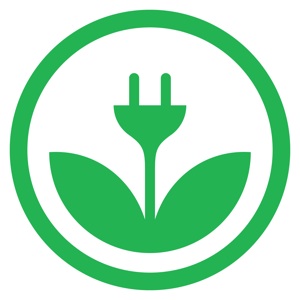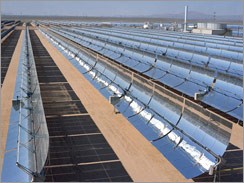Related Research Articles
The United Kingdom's Climate Change Programme was launched in November 2000 by the British government in response to its commitment agreed at the 1992 United Nations Conference on Environment and Development (UNCED). The 2000 programme was updated in March 2006 following a review launched in September 2004.
Renewable Energy Certificates (RECs), also known as Green tags, Renewable Energy Credits, Renewable Electricity Certificates, or Tradable Renewable Certificates (TRCs), are tradable, non-tangible energy certificates in the United States that represent proof that 1 megawatt-hour (MWh) of electricity was generated from an eligible renewable energy resource and was fed into the shared system of power lines which transport energy. Solar renewable energy certificates (SRECs) are RECs that are specifically generated by solar energy.

Renewable energy progress in the European Union (EU) is driven by the European Commission's 2023 revision of the Renewable Energy Directive, which raises the EU's binding renewable energy target for 2030 to at least 42.5%, up from the previous target of 32%. Effective since November 20, 2023, across all EU countries, this directive aligns with broader climate objectives, including reducing greenhouse gas emissions by at least 55% by 2030 and achieving climate neutrality by 2050. Additionally, the Energy 2020 strategy exceeded its goals, with the EU achieving a 22.1% share of renewable energy in 2020, surpassing the 20% target.

In environmental policy, white certificates are documents certifying that a certain reduction of energy consumption has been attained. In most applications, the white certificates are tradable and combined with an obligation to achieve a certain target of energy savings. Under such a system, producers, suppliers or distributors of electricity, gas and oil are required to undertake energy efficiency measures for the final user that are consistent with a pre-defined percentage of their annual energy deliverance. If energy producers do not meet the mandated target for energy consumption they are required to pay a penalty. The white certificates are given to the producers whenever an amount of energy is saved whereupon the producer can use the certificate for their own target compliance or can be sold to (other) parties who cannot meet their targets. Quite analogous to the closely related concept of emissions trading, the tradability in theory guarantees that the overall energy saving is achieved at least cost, while the certificates guarantee that the overall energy saving target is achieved.

The energy policy of the European Union focuses on energy security, sustainability, and integrating the energy markets of member states. An increasingly important part of it is climate policy. A key energy policy adopted in 2009 is the 20/20/20 objectives, binding for all EU Member States. The target involved increasing the share of renewable energy in its final energy use to 20%, reduce greenhouse gases by 20% and increase energy efficiency by 20%. After this target was met, new targets for 2030 were set at a 55% reduction of greenhouse gas emissions by 2030 as part of the European Green Deal. After the Russian invasion of Ukraine, the EU's energy policy turned more towards energy security in their REPowerEU policy package, which boosts both renewable deployment and fossil fuel infrastructure for alternative suppliers.
The Directive on the promotion of cogeneration based on a useful heat demand in the internal energy market and amending Directive 92/42/EEC, officially Directive 2004/8/EC, is a European Union directive for promoting the use of cogeneration, popularly better known as the 'Combined Heat and Power (CHP) Directive'.

Renewable energy in the United Kingdom contributes to production for electricity, heat, and transport.

Renewable energy in Spain, comprising bioenergy, wind, solar, and hydro sources, accounted for 15.0% of the Total Energy Supply (TES) in 2019. Oil was the largest contributor at 42.4% of the TES, followed by gas, which made up 25.4%.
The Association of Issuing Bodies (AIB) promotes the use of a standardised system European Energy Certificate System (EECS), based on structures and procedures to ensure the reliable operation of international energy certificate systems. European Energy Certificate System (EECS) is set out in "The EECS Rules" and its supporting documents.
The European Energy Certificate System (EECS) is an integrated European framework for issuing, transferring and cancelling EU energy certificates. It was developed by the Association of Issuing Bodies to provide a properly regulated platform for Renewable Energy Guarantees of Origin, as proposed by the EU Renewable Energy Directive (RED). EECS supports all types of energy, regardless of source or production technology.

An energy certificate or energy attribute certificate is a transferable record or guarantee related to the amount of energy or material goods consumed by an energy conversion device in industrial production. A certificate may be in any form, including electronic, and lists attributes such as method, quality, compliance, and tracking.
The Renewable Energy Certificate System (RECS) was a voluntary system for international trade in renewable energy certificates that was created by RECS International to stimulate the international development of renewable energy. It advocated the use of a standard energy certificate to provide evidence of the production of a quantity of renewable energy and provided a methodology that enables renewable energy trade, enabling the creation of a market for renewable energy and so promoting the development of new renewable energy capacity.

EKOenergy is a globally active nonprofit ecolabel for renewable energy. It is owned by the Finnish Association for Nature Conservation and managed in cooperation with other environmental NGOs.

Energy in Sweden describes energy and electricity production, consumption and import in Sweden. Electricity sector in Sweden is the main article of electricity in Sweden. The Swedish climate bill of February 2017 aims to make Sweden carbon neutral by 2045. The Swedish target is to decline emission of climate gases 63% from 1990 to 2030 and international transportation excluding foreign flights 70%. By 2014 just over half of the country's total final energy consumption in electricity, heating and cooling and transport combined was provided by renewables, the highest share amongst the then 28 EU member countries. About a third of Sweden's electricity is generated by nuclear power. In generating a year's worth of this energy, Swedes generate about 4 tonnes of CO2 emissions each. Since 2010, sustainability measures have reduced total emissions even as the population has increased.

The Poland National Renewable Energy Action Plan is the National Renewable Energy Action Plan (NREAP) for Poland. The plan was commissioned by the Directive 2009/28/EC which required Member States of the European Union to notify the European Commission with a road map. The report describes how Poland planned to achieve its legally binding target of a 15% share of energy from renewable sources in gross final consumption of energy by 2020.

Energy in Greece is dominated by fossil gas and oil. Electricity generation is dominated by the one third state owned Public Power Corporation. In 2009 DEI supplied for 85.6% of all electric energy demand in Greece, while the number fell to 77.3% in 2010. Almost half (48%) of DEI's power output in 2010 was generated using lignite. 12% of Greece's electricity comes from hydroelectric power plants and another 20% from natural gas. Between 2009 and 2010, independent companies' energy production increased by 56%, from 2,709 Gigawatt hour in 2009 to 4,232 GWh in 2010.
Denmark is a leading country in renewable energy production and usage. Renewable energy sources collectively produced 81% of Denmark's electricity generation in 2022, and are expected to provide 100% of national electric power production from 2030. Including energy use in the heating/cooling and transport sectors, Denmark is expected to reach 100% renewable energy in 2050, up from the 34% recorded in 2021.

A consumer green energy program is a program that enables households to buy energy from renewable sources. By allowing consumers to purchase renewable energy, it simultaneously diverts the utilization of fossil fuels and promotes the use of renewable energy sources such as solar and wind.

The Energy Taxation Directive or ETD (2003/96/EC) is a European directive, which establishes the framework conditions of the European Union for the taxation of electricity, motor and aviation fuels and most heating fuels. The directive is part of European Union energy law; its core component is the setting of minimum tax rates for all Member States.
References
- ↑ "Reliability >>". www.aib-net.org. Archived from the original on 24 July 2018. Retrieved 8 May 2017.
- ↑ "Reliability >>". www.aib-net.org. Archived from the original on 24 July 2018. Retrieved 8 May 2017.
- ↑ see Directives 2018/2001(EU), 2001/77/EC, 2004/8/EC and logically 2003/54/EC, all applicable in the European Economic Area (EEA).
- ↑ "Content >>". www.aib-net.org. Retrieved 24 July 2018.
- ↑ Böck, Hanno (11 May 2023). "How Iceland sold the same Green Electricity twice". Industry Decarbonization Newsletter. Retrieved 19 June 2023.
- ↑ "Regarding the compliance assessment of Landsnet's possible breach of EECS Rules N9.1.1, A2.1.2, C3.3.1 and E3.3.14" (PDF). AIB. 27 April 2023. Retrieved 19 June 2023.
- ↑ "Regarding the compliance assessment of Landsnet's possible breach of the EECS Rules" (PDF). AIB. 1 June 2023. Retrieved 19 June 2023.
- ↑ Böck, Hanno (5 June 2023). "Double Counting and other problems with Green Electricity Certificates". Industry Decarbonization Newsletter. Retrieved 19 June 2023.
- ↑ Brander, Matthew. "Renewable Energy Purchasing and the Market-based (Scope 2) Method". University of Edinburgh Business School. Retrieved 5 August 2023.